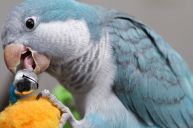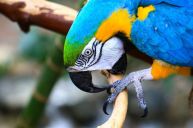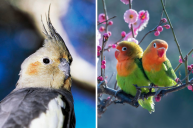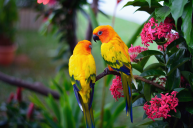Have you always wanted a pet that you could carry on a conversation with? The African grey parrot can closely mimic human speech, so much so that you might question whether there's another human in the room with you. This parrot makes for a fascinating and entertaining pet.
But before you bring home a parrot, it's important to be prepared for all of the care that an African grey will need. This parrot species is highly intelligent and love to be active. Plus, with a lifespan of up to 60 years, adding a parrot to your home is a long-term commitment. Here is everything you need to know about the African grey parrot.
African Grey Parrot Species
There are two different subspecies of the African grey parrot: the Congo African grey and the Timneh African grey. While both subspecies look similar, there are distinct differences between the two.
The Congo African grey parrot is the larger of the two species, measuring approximately 12 to 14 inches in length and weighing 16 ounces. Native to Africa, the Congo African grey parrot originates from the Central African regions of southeastern Ivory Coast, Western Kenya, Tanzania, and Angola.
The Timneh African grey parrot is a bit smaller than the Congo, measuring approximately 10 inches in length and weighing around 10.5 ounces. The Timneh African grey parrot is also native to Africa, but found in the western coastal regions of Guinea, Ghana, and the Ivory Coast.
Unique Characteristics
What makes the African grey parrot such a popular pet is their high intelligence and speaking ability. Known as the Einstein of birds, the African grey parrot can learn up to 1,500 different words. Not only are their vocabularies extensive, but the Congo can also actually learn to speak in different voices. The Timneh, however, does not mimic other people's voices; they have their own individual voice they speak in.
While both species of African grey parrots are very vocal, Timnehs begin to speak earlier than the Congos, at six months of age. This is likely due to the fact that they mature earlier than Congos, giving them the ability to speak sooner. Congos tend to begin to speak at anywhere between 12 and 18 months of age.
The most famous African Grey is Alex, a bird studied for years by Dr. Irene Pepperberg, a researcher at Harvard University. Alex has been shown to have the ability to process information and make appropriate choices with the correct choice of words.
Caring for the African Grey Parrot
Obviously, the African grey parrot is a very intelligent creature. In fact, some have actually been shown to perform at the cognitive level of a four- to a six-year-old child in some tasks. Due to this high intelligence, the African grey parrot needs lots of stimulation both in and out of the cage.
They love playing with toys and are great climbers, so owners should have plenty of activities for their African grey parrot to entertain themselves with. If they become bored they can start showing undesirable behaviors such as feather plucking or biting. Due to the potential behavioral issues that come with such an intelligent bird, African grey parrots are not recommended for first-time owners.
African grey parrots have a lifespan of between 40 and 60 years.
But does their popularity create a demand for this highly intelligent bird? Are these wild birds trafficked for the pet trade?
According to Thedodo.com,
"Prior to 1992, most African grey parrots sold in pet stores in the U.S. came from the wild. But when the Wild Bird Conservation Act came into effect in 1992, it became illegal to bring wild-caught birds into the U.S., which helped restrict the national demand for wild-caught birds." Both the Timneh Grey and Congo African Grey Parrots are unfortunately endangered.
One wonderful resource for anyone interested in these parrots is the World Parrot Trust.
Hover over the image for more information.




